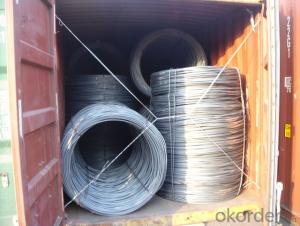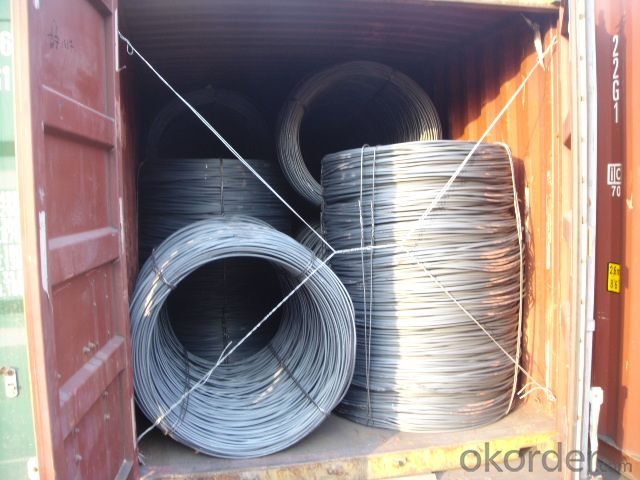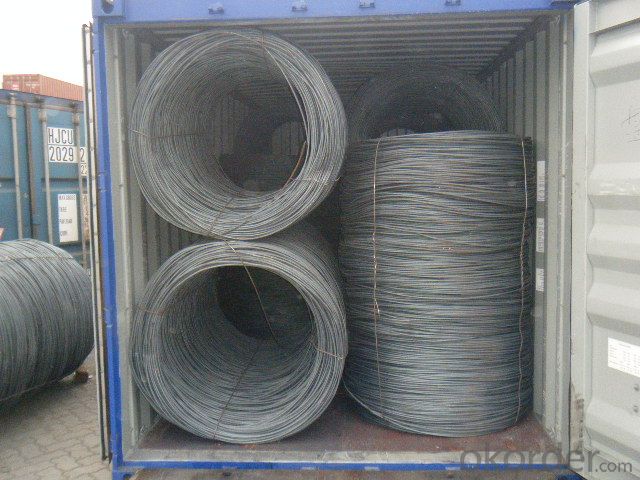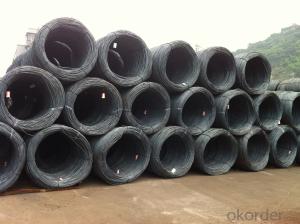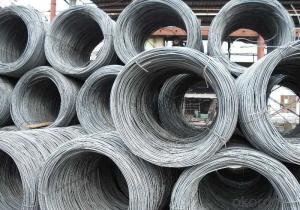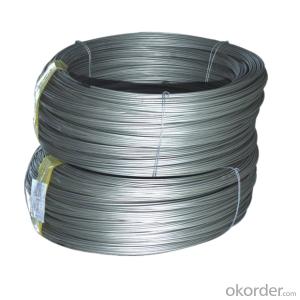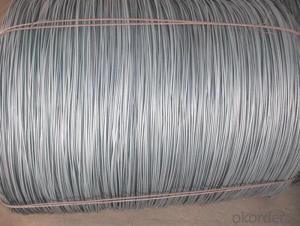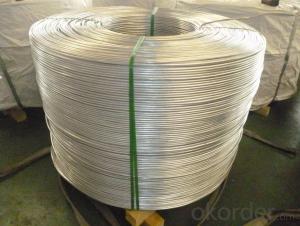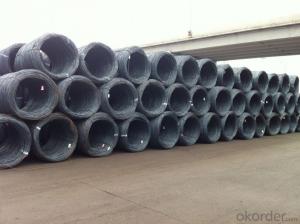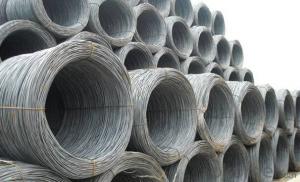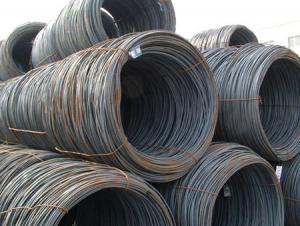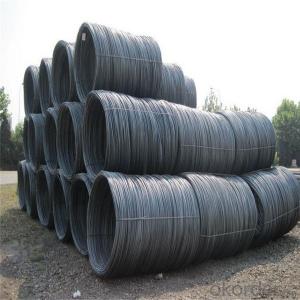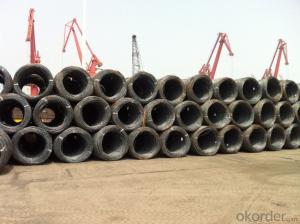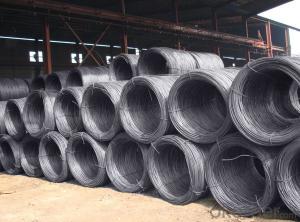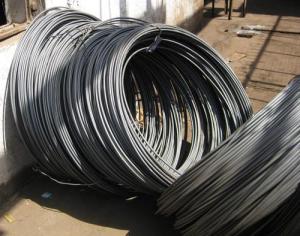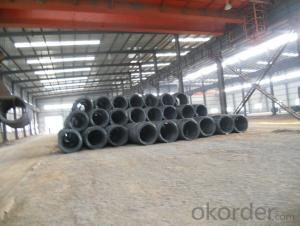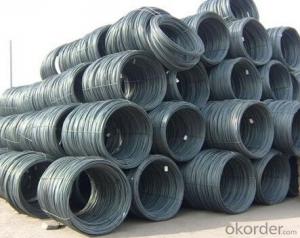steel wire rope price SAE1008 100 Metric Ton
- Loading Port:
- Tianjin
- Payment Terms:
- TT OR LC
- Min Order Qty:
- 20 m.t.
- Supply Capability:
- 18000 m.t./month
OKorder Service Pledge
OKorder Financial Service
You Might Also Like
Specifications
steel wire rope price
1)Grade:Q195/235,SAE1010,SAE1008,SAE1018B
2)Dia:5.5-14mm
3)Moq: 100 tons
4)Proce:FOB520-575usd/ton
steel wire rope price SAE1008
1.Diameter: 5.5mm-14mm
2.Material:Q195-235; SAE1008-SAE1018
3.surface:round,no twisted,light and smooth
4.Coil weight:1.8-2.1ton
5. Measurement of Weight: By Actual Weighting
6.Coil OD:1.1M
7.Applicant: wire drawing,welding electrode, nail
8.Payment term: TT or L/C at sight
Please kindly find our chemistry of our material based on SAE1006B and SAE1008B as below for
your information:
Grade | Chemical Composition(%) | |||||
C | Mn | Si | S | P | B | |
SAE1006B | 0.03~O.07 | ≤0.32 | ≤0.30 | ≤0.045 | ≤0.040 | >0.0008 |
Mechanical properties | ||||||
Yield strength(N/mm2) | Tensile strength(N/mm2) | Elongation(%) | ||||
250-280 | 350-380 | ≥32 | ||||
Grade | Chemical Composition(%) | |||||
C | Mn | Si | S | P | B | |
SAE1008B | 0.10max | 0.3~O.50 | 0.15max | 0.050max | 0.040 max | 0.0008 min |
Mechanical properties | ||||||
Yield strength(N/mm2) | Tensile strength(N/mm2) | Elongation(%) | ||||
≥195 | 315-430 | ≥30 | ||||
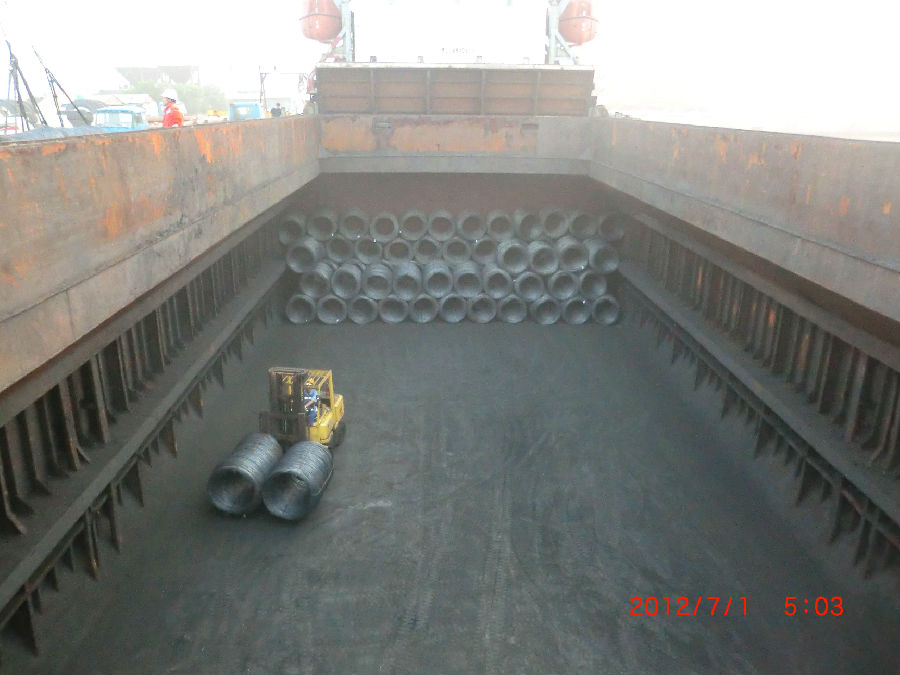
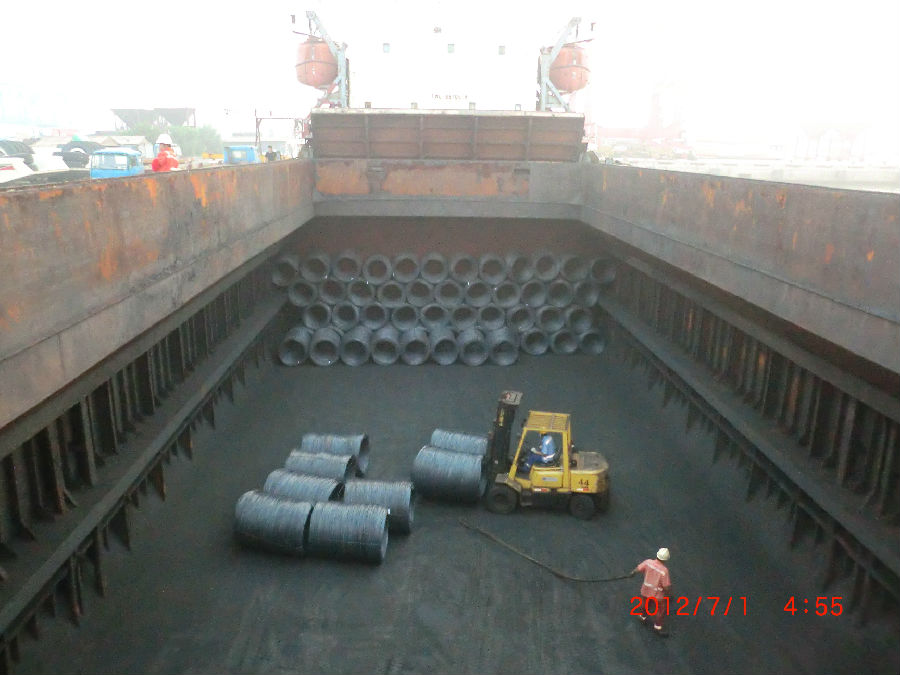
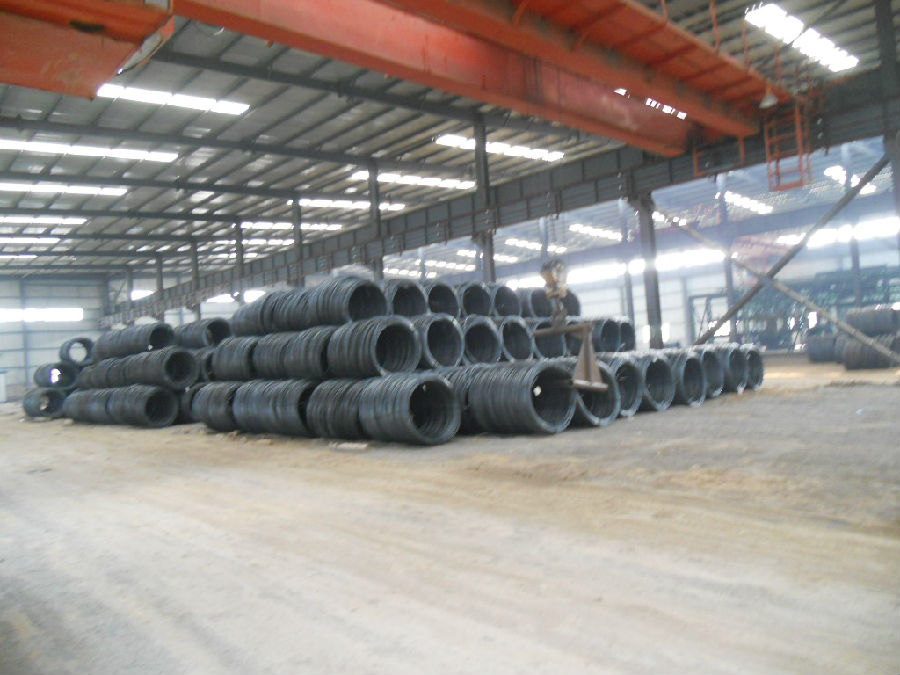
- Q: What are the common standards and certifications for steel wire rod?
- Steel wire rod must adhere to various standards and certifications to ensure its quality and compliance with industry regulations. Some widely recognized ones include: 1. ASTM International Standards: Commonly used for steel wire rod are ASTM A510 and ASTM A853. These standards outline the necessary requirements for carbon steel wire rods used in various applications, such as wire product manufacturing, nail production, and fencing. 2. ISO Certification: ISO 9001 is a well-known quality management system standard that guarantees consistent quality and customer satisfaction. Many steel wire rod manufacturers obtain ISO 9001 certification, indicating their commitment to rigorous quality control processes. 3. European Standards (EN): EN 10016-2 is a standard specifically applicable to wire rod manufactured and used within the European Union. It specifies the technical delivery conditions for non-alloy steel wire rod used for general purposes. 4. American Petroleum Institute (API) Certification: API Spec 5L is a certification specifically relevant to steel wire rod used in the oil and gas industry. This certification ensures that the wire rod meets the necessary requirements for use in pipelines and related applications. 5. International Electrotechnical Commission (IEC) Standards: IEC 60949 is a standard that specifies the requirements for copper or aluminum wire rod used in electrical purposes. Although not specifically for steel wire rod, the electrical industry follows IEC standards to ensure safety and performance. It is crucial to note that different applications may have specific requirements, and manufacturers often comply with additional industry-specific certifications or customer-specific standards. These certifications and standards are vital in maintaining consistent quality, safety, and performance of steel wire rod in various industries.
- Q: How is the steel wire rod industry affected by fluctuations in raw material prices?
- The steel wire rod industry experiences significant effects due to fluctuations in raw material prices. Raw materials, including iron ore, coal, and scrap metal, play a crucial role in the production of steel wire rods. Any changes in the prices of these raw materials can directly influence the production costs for manufacturers of steel wire rods. When there is an increase in raw material prices, it directly raises the input costs for producing steel wire rods. This situation puts pressure on manufacturers to either absorb the higher costs, leading to reduced profit margins, or pass on the increased costs to customers in the form of higher prices. In either scenario, the competitiveness of steel wire rod manufacturers in the market can be impacted. On the contrary, when there is a decrease in raw material prices, it can provide some relief to steel wire rod manufacturers as it reduces their production costs. This enables manufacturers to offer lower prices or maintain their profit margins while remaining competitive in the market. Fluctuations in raw material prices also have an impact on the supply chain of the steel wire rod industry. Manufacturers depend on a steady supply of raw materials, and any disruptions or price volatility can affect their ability to procure sufficient quantities of raw materials. This can result in production delays, higher inventory costs, and overall productivity issues in the industry. Furthermore, fluctuations in raw material prices can also influence the profitability of steel wire rod manufacturers. If raw material prices increase significantly and manufacturers are unable to pass on the increased costs to customers, it can lead to reduced profitability and potentially financial losses. Conversely, when raw material prices decrease, manufacturers may experience improved profitability. In conclusion, fluctuations in raw material prices directly impact various aspects of the steel wire rod industry, including production costs, competitiveness, supply chain, and profitability. Consequently, industry players closely monitor and analyze trends in raw material prices to make informed decisions and mitigate the impacts of price fluctuations.
- Q: How is steel wire rod used in the manufacturing of wire grilles?
- Steel wire rod is used in the manufacturing of wire grilles as the primary material for creating the intersecting wires that form the grid-like structure of the grille. The steel wire rod is typically drawn through a series of dies to reduce its diameter and increase its tensile strength, making it suitable for withstanding the pressure and tension required in wire grilles. Once the steel wire rod is shaped into the desired gauge and thickness, it is welded or interwoven to create the grid pattern, providing strength, stability, and security to the wire grille.
- Q: How is steel wire rod stored in a warehouse or distribution center?
- To ensure convenient access, safety, and damage prevention, steel wire rod is typically stored in a warehouse or distribution center in a well-ordered manner. It is common practice to store the wire rod in long, cylindrical bundles or coils, the size and weight of which vary based on specific requirements. In order to store the steel wire rod, the warehouse or distribution center employs a combination of racks, shelves, or specially designed storage systems. These storage systems are tailored to accommodate the weight and dimensions of the wire rod bundles or coils, ensuring stability and mitigating potential hazards. In certain instances, wire rods are stacked vertically on racks or shelves, with each bundle or coil placed on top of the other. This vertical storage method optimizes space utilization and facilitates the identification of different types or sizes of wire rod. Alternatively, wire rod may also be stored horizontally on racks or shelves. This approach is frequently employed when the wire rods are too heavy or lengthy to be stored vertically. Horizontal storage facilitates easier handling and guards against deformation or damage to the wire rod. Regardless of the chosen storage method, it is imperative to maintain a dry and well-ventilated environment to prevent corrosion of the steel wire rod. Additionally, proper labeling and documentation play a crucial role in efficiently identifying and tracking the wire rod inventory. Overall, the storage of steel wire rod in a warehouse or distribution center necessitates meticulous planning and organization to ensure efficiency, safety, and the preservation of the wire rod's quality.
- Q: What is the average price of steel wire rod?
- The average price of steel wire rod can vary depending on several factors including market demand, production costs, and global economic conditions. As of [current year], the average price of steel wire rod ranges from [price range] per metric ton. However, it is important to note that prices can fluctuate significantly over time, so it is always recommended to consult with industry experts or suppliers for the most up-to-date and accurate pricing information.
- Q: What are the main factors influencing the choice of steel wire rod order payment refund options?
- The choice of payment refund options for steel wire rod orders can be influenced by a variety of factors. However, there are several common factors that play a significant role in this decision-making process, including: 1. Supplier Reputation: A crucial factor is the reputation and trustworthiness of the supplier. Buyers often choose payment refund options that provide a sense of security in case of any issues or disputes with the supplier. 2. Order Volume and Value: The size and value of the steel wire rod order can impact the choice of payment refund options. Larger orders with higher values may require more secure refund options to mitigate potential financial risks. 3. Payment Terms and Conditions: The payment terms and conditions set by the supplier can also influence the choice of refund options. Some suppliers may offer specific refund options based on their preferred payment methods, such as bank transfers, letters of credit, or escrow services. 4. Buyer's Financial Capability: The financial capability of the buyer can also determine the choice of refund options. Buyers with limited financial resources may opt for payment refund options that offer flexibility and minimize risks, such as installment payments or delayed payment terms. 5. Delivery and Quality Assurance: The reliability and quality assurance provided by the supplier can impact the choice of refund options. Buyers may prefer refund options that allow them to inspect the steel wire rod upon delivery and ensure compliance with the agreed specifications before making full payment. 6. Market Conditions and Competition: Market conditions and competition among suppliers can influence the choice of refund options. Buyers may consider refund options that are more favorable or competitive in the market, such as cash discounts or rebates. 7. Legal and Regulatory Considerations: Legal and regulatory requirements in the buyer's jurisdiction can also affect the choice of refund options. Buyers may opt for refund options that comply with local regulations and provide legal protection in case of any disputes or non-compliance. Buyers should carefully evaluate these factors and assess their specific needs and preferences before deciding on the most suitable payment refund options for their steel wire rod orders.
- Q: How are steel wire rods used in the manufacturing of wire mesh for reinforcement?
- Steel wire rods are used in the manufacturing of wire mesh for reinforcement by being drawn through dies of various sizes and shapes to form the desired wire diameter and mesh pattern. These wire rods provide the strength and durability needed to reinforce concrete structures, such as walls, columns, and slabs, by being embedded within the concrete to enhance its tensile strength and prevent cracking or deformation under stress.
- Q: How is the ductility of steel wire rod determined?
- The ductility of steel wire rod is determined through a test called the tensile test. In this test, a sample of the wire rod is pulled until it breaks, and the amount of deformation it undergoes before breaking is measured. This deformation provides an indication of the wire rod's ability to be stretched without fracturing, which determines its ductility.
- Q: What are the safety considerations when handling steel wire rods?
- When handling steel wire rods, there are several important safety considerations to keep in mind. 1. Personal Protective Equipment (PPE): It is essential to wear the appropriate PPE to protect yourself from any potential hazards. This may include safety glasses, gloves, and steel-toed boots to prevent injuries from falling rods or accidental contact. 2. Proper Lifting Techniques: Steel wire rods can be heavy and awkward to handle. It is crucial to use proper lifting techniques, such as bending your knees and lifting with your legs, to prevent strains or back injuries. 3. Storage and Handling: Steel wire rods should be stored in a designated area that is well-organized and secure. They should be stacked in a stable manner to prevent them from falling over and causing injuries. Additionally, it is important to ensure that the rods are not exposed to moisture or extreme temperatures, as this can affect their integrity. 4. Sharp Edges and Points: Steel wire rods often have sharp edges and points, which can cause cuts or puncture wounds. It is important to handle them with care and use appropriate tools, such as wire cutters or pliers, to avoid direct contact with the sharp areas. 5. Transport and Loading: When transporting or loading steel wire rods, it is essential to secure them properly to prevent them from shifting or falling during transit. This may involve using appropriate tie-downs, straps, or other restraints to keep the rods in place. 6. Training and Awareness: All individuals handling steel wire rods should receive proper training on safe handling procedures and be aware of potential hazards. Regular safety meetings and reminders can help reinforce the importance of following safety protocols. By considering these safety measures, you can help mitigate the risks associated with handling steel wire rods and ensure a safe working environment for all involved.
- Q: What are the common production processes for americium-coated steel wire rod?
- The common production processes for americium-coated steel wire rod typically involve a series of steps. First, the steel wire rod is manufactured through processes such as hot rolling or cold drawing to obtain the desired dimensions and characteristics. Next, the americium coating is applied onto the steel wire rod using methods such as electrodeposition or physical vapor deposition. This ensures a uniform and adherent coating of americium on the surface of the steel wire rod. Finally, the coated wire rod is subjected to quality control checks and may undergo additional treatments or processing, depending on the intended application.
Send your message to us
steel wire rope price SAE1008 100 Metric Ton
- Loading Port:
- Tianjin
- Payment Terms:
- TT OR LC
- Min Order Qty:
- 20 m.t.
- Supply Capability:
- 18000 m.t./month
OKorder Service Pledge
OKorder Financial Service
Similar products
Hot products
Hot Searches
Related keywords
